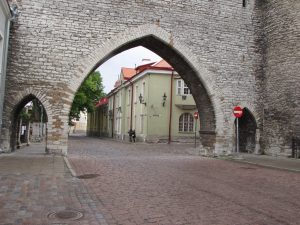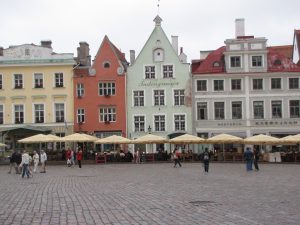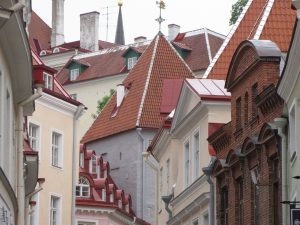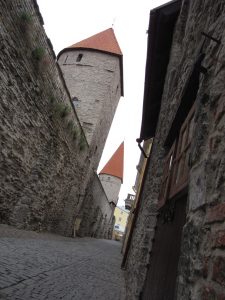town , where the lovely coloured superstructures, medieval houses, with flowers in the windows, 
 narrow street lanes, present a wonderful history lesson.
narrow street lanes, present a wonderful history lesson.  Admiring beauty of this town , visitors discover the latent wealth of historical past and a multi-age influences of Denmark, Sweden, Poland , Lithuania , Russia on this region of the former Livonia , today Estonia . The first experience of the beautiful capital of independent Estonia, looking at the church towers, defensive walls, merchants homes and store houses , guests connect instantly with distant times of the history pages of Estonia. Country where on its patch of the Baltic Sea region, Denmark, Sweden, Tsarist Russia and Poland fought for supremacy . Big influence into this region was brought by German culture represented by the Union of Hanseatic towns . Currently, Estonia enjoys a peaceful independence of the status of a member of the European Community, which should be mentioned, is handling well the problems of the GFC – Global Financial Crisis .In Tallinn in a great atmosphere providing a rich history of Estonia, the tourists also come into contact with the dynamism of a modern country, a country with strong economy and a prosperous finances. One of the earliest historical records,
Admiring beauty of this town , visitors discover the latent wealth of historical past and a multi-age influences of Denmark, Sweden, Poland , Lithuania , Russia on this region of the former Livonia , today Estonia . The first experience of the beautiful capital of independent Estonia, looking at the church towers, defensive walls, merchants homes and store houses , guests connect instantly with distant times of the history pages of Estonia. Country where on its patch of the Baltic Sea region, Denmark, Sweden, Tsarist Russia and Poland fought for supremacy . Big influence into this region was brought by German culture represented by the Union of Hanseatic towns . Currently, Estonia enjoys a peaceful independence of the status of a member of the European Community, which should be mentioned, is handling well the problems of the GFC – Global Financial Crisis .In Tallinn in a great atmosphere providing a rich history of Estonia, the tourists also come into contact with the dynamism of a modern country, a country with strong economy and a prosperous finances. One of the earliest historical records,  where name AESTII , from which Estonia derives the name , can be found in records of Tacitus , dating to the first century AD . This region, as written in the 5th century by Roman historian Cassiodorus was known to be domiciled by Estonians. For
where name AESTII , from which Estonia derives the name , can be found in records of Tacitus , dating to the first century AD . This region, as written in the 5th century by Roman historian Cassiodorus was known to be domiciled by Estonians. For
a long period of European history,  this was the area of influence of fights and wars of Vikings, Scandinavians, Russian tribes, Finns and the Polish Crown. Strolling among the retreats of Old Town, surrounded by huge walls, with soaring defending towers of the town and the guarded gates ,one can easily get lost in fantasies about distant times of European history. Beautifully restored , thanks to financial support of UNESCO, 13-th century houses and places bring travellers within the world of unprecedented experiences. One of the central places of the old town, situated at the foot of Toompea Hill, is Raekoja plats. At this attractive square, there is plentiful of interesting, full of history buildings. City Council Building RAEKODA boldly determined by a diamond’s Gothic architecture was founded in 1404 .The building presents enormous wealth of exterior stonework as well as sculptural artistry seen on the fifteenth – century interiors, rooms and chambers of the unique design and architecture. On the square there is also Raekoja ,where one experiences wonderfully unique architecture as well as pharmacists craftsmanship, dated since at least 1422 years, is
this was the area of influence of fights and wars of Vikings, Scandinavians, Russian tribes, Finns and the Polish Crown. Strolling among the retreats of Old Town, surrounded by huge walls, with soaring defending towers of the town and the guarded gates ,one can easily get lost in fantasies about distant times of European history. Beautifully restored , thanks to financial support of UNESCO, 13-th century houses and places bring travellers within the world of unprecedented experiences. One of the central places of the old town, situated at the foot of Toompea Hill, is Raekoja plats. At this attractive square, there is plentiful of interesting, full of history buildings. City Council Building RAEKODA boldly determined by a diamond’s Gothic architecture was founded in 1404 .The building presents enormous wealth of exterior stonework as well as sculptural artistry seen on the fifteenth – century interiors, rooms and chambers of the unique design and architecture. On the square there is also Raekoja ,where one experiences wonderfully unique architecture as well as pharmacists craftsmanship, dated since at least 1422 years, is  town pharmacy-
town pharmacy-
RAEAPTEEK. Pharmacy with display of, unprecedented medieval examples of medicaments like dried frogs, herbs , leaches , roots , attracts attention of many tourists .On the Raekoja Square in many restaurants one can enjoy the specialties of Estonian cuisine . Fish dishes like eel, famous “ sprats” of the Baltic Sea or meat dish specialties where “game” of the Estonian forests , like bear cutlets or “Soljanka” hot soup for main course with beer during the summer whims of the region aura, when cold wind blows from the northern Baltic Sea, are welcome experiences while exploring the city. Near the square Raekoja, there is attractive Marzipan Museum 
 presenting jewels of great craftsmanship. One can visit the place and buy something sweet for dessert after a delicious lunch . Estonians claim the right to call their marzipan best in the World . After a tasty meal ended with dessert, strolling the streets of Tallinn’s beautiful , at every step surprising town , lanes and alleys where history in form of attractive and stylish buildings is true delight . Churches like the thirteenth – century “Puha Vaimu Kirki” Church of the Holy Spirit, or ” Niguliste “church dating from the fifteenth century and also “ Dominikklaste Klooster “Dominican Monastery founded in 1246 one of the oldest buildings in the city, in which Interestingly there is a museum where you can view the room in which monks lived, can bring feelings of fascination with remote history of Tallinn. “Katarina Kaike” St. Catherine’s Marketplace, this narrow passage among the stone walls, hoods, bows supporting adjacent buildings, where you can boldly say, while absorbing air from the distant times of Tallinn, one feels like in Medieval times .
presenting jewels of great craftsmanship. One can visit the place and buy something sweet for dessert after a delicious lunch . Estonians claim the right to call their marzipan best in the World . After a tasty meal ended with dessert, strolling the streets of Tallinn’s beautiful , at every step surprising town , lanes and alleys where history in form of attractive and stylish buildings is true delight . Churches like the thirteenth – century “Puha Vaimu Kirki” Church of the Holy Spirit, or ” Niguliste “church dating from the fifteenth century and also “ Dominikklaste Klooster “Dominican Monastery founded in 1246 one of the oldest buildings in the city, in which Interestingly there is a museum where you can view the room in which monks lived, can bring feelings of fascination with remote history of Tallinn. “Katarina Kaike” St. Catherine’s Marketplace, this narrow passage among the stone walls, hoods, bows supporting adjacent buildings, where you can boldly say, while absorbing air from the distant times of Tallinn, one feels like in Medieval times .  Not far from
Not far from
this passage, on Vene Street 18, there is a nicely preserved the Catholic Church of St. Peter and Paul, who is very closely related to Polish history. This is one of the two churches of the Roman – Catholic faith in Tallinn. Strolling the streets, roam the various corners of the tiny Old Town Talinn , one always reaches cube stones road of entry into the Toompea Hill where wonderful views of the Lower Old Town with its great building and structures , spreads . The “Pikk JALG” charming approach to the hill crowned by the Castle Square where a beautiful Palace is placed .  Today it is
Today it is
the seat of Parliament, where tri-colored flag of free Estonia flows. Through seven centuries, in various art and architectural styles now Palace represents eighteenth century Baroque style of its outer elevation . Palace stands on the place of amazing multi-age stories of Estonia , where always it was the seat of power. It is a place where old fortress, around year 1219, once upon proudly stood and provided defence for the city against the invasion of Danish troops. Denmark one can state gave the foundation for the statehood and all administrative concepts for Estonia . Unfortunately for many centuries , despite its rich national traditions , Estonia was under the influence of neighbouring countries . Sweden, Russia, Prussia, the “Hansa ” culture which gave town its other name of REVAL , as well as Poland, while exercising their military powers ,played a dominant role on development of Estonian history. One of the examples of influence on Estonia is Eastern Rite Christianity example of , the dominant architectural structure of , “Alexander Nevski” Cathedral .  It was raised in 1894 by
It was raised in 1894 by
Tsar Alexander III decision , who named it by the name of the thirteenth century hero of Russia, who then conquered south-eastern Estonia and Pskov. Construction of the Cathedral designed by famous architect of St. Petersburg Michail Preobrazhensky ,was completed in 1900. As legend has it this Cathedral being on the place , where the tomb of the hero of Estonia Kalev supposed to be resting ,is cursed and has serious design flaws . This Cathedral being great architectural example of old orthodox style and is called Russian Revival style . Toomkirik, also known as St. Mary’s Church, being the oldest church in Estonia was build during the first wave of Danish invasions in 1219 and for the visitors is worth of attention .  Slender, with a fourteenth century Gothic interior brings visitors into interesting atmosphere, especially where the grave of Thuve Johann OTTO, called Don Juan of Estonia is located . He was well known owner of Edis Vääna and Koonu towns and is also famous for his cheerful personality, as it was shown by his presence in large festivities with singing, great quantities of wine and women as well. In 1696 he was buried according to wishes on the threshold of entrance into the Church allowing as he wanted all kneeling to prayer, helping his soul with its salvation . Interesting part of the period of the sixteenth century the history of Estonia was the “Livonian War” in which the offensive by the famous King Stefan Batory took place . Traces of these military struggles, of years 1558 – 1583 ,with Tsarist Russia in which beside Poland and Lithuania were also engaged coalition troops of Denmark, Norway and the Kingdom of Sweden, are visible on the defence walls of tower, called “Kiek in de Kok” which means “Looking into the kitchen.” The walls of this tower, dating its existence from 1481 hold in its body bedded 9 cannon balls fired from the cannons of Tsar Ivan IV. Not far from the Old Town of Tallinn, a short trip by tram, there is a Kadriorg. This is a beautiful recreation complex.
Slender, with a fourteenth century Gothic interior brings visitors into interesting atmosphere, especially where the grave of Thuve Johann OTTO, called Don Juan of Estonia is located . He was well known owner of Edis Vääna and Koonu towns and is also famous for his cheerful personality, as it was shown by his presence in large festivities with singing, great quantities of wine and women as well. In 1696 he was buried according to wishes on the threshold of entrance into the Church allowing as he wanted all kneeling to prayer, helping his soul with its salvation . Interesting part of the period of the sixteenth century the history of Estonia was the “Livonian War” in which the offensive by the famous King Stefan Batory took place . Traces of these military struggles, of years 1558 – 1583 ,with Tsarist Russia in which beside Poland and Lithuania were also engaged coalition troops of Denmark, Norway and the Kingdom of Sweden, are visible on the defence walls of tower, called “Kiek in de Kok” which means “Looking into the kitchen.” The walls of this tower, dating its existence from 1481 hold in its body bedded 9 cannon balls fired from the cannons of Tsar Ivan IV. Not far from the Old Town of Tallinn, a short trip by tram, there is a Kadriorg. This is a beautiful recreation complex. The Baroque palace surrounded by manicured garden was built by Peter the Great, Tsar of Russia. This is where the open space in the park, after discovering the attractions of old , narrow streets of Tallinn’s Old Town, provides while strolling among the green grass and flowery gardens flowerbeds of the palace , great reward of pleasing relaxation moments .
The Baroque palace surrounded by manicured garden was built by Peter the Great, Tsar of Russia. This is where the open space in the park, after discovering the attractions of old , narrow streets of Tallinn’s Old Town, provides while strolling among the green grass and flowery gardens flowerbeds of the palace , great reward of pleasing relaxation moments .  Taking into account
Taking into account the geographical location of Tallinn in relation to the Poland , only 1 ½ hour flight from Warsaw, one should look at a plan for a small trip to this friendly city while using LOT Polish Airlines offers of frequent connections at the same time also enjoying attractive price offers for flights from Warsaw to Tallinn.
the geographical location of Tallinn in relation to the Poland , only 1 ½ hour flight from Warsaw, one should look at a plan for a small trip to this friendly city while using LOT Polish Airlines offers of frequent connections at the same time also enjoying attractive price offers for flights from Warsaw to Tallinn.
WMIG
 Mitch Godziemba Swiat
Mitch Godziemba Swiat mitchgodziemba
mitchgodziemba